Isabella Bradford's Blog, page 16
April 12, 2018
Friday Video: Listen to the Earliest Known Surviving Piano
Susan reporting,
While we were away on our spring break, we missed one of those daily celebrations that the Internet so loves, and honors with a hashtag: #PianoDay. Fittingly, this was the eighty-eighth day of the year, with a day for each of a piano's keys.
But perhaps everyday should be piano day. In the world of instruments, pianos are relative newcomers. The first were invented by Venetian-born Bartolomeo Cristofori (1655-1732), who built instruments for the Medici court in Florence. The piano in this video is the earliest known to survive today, and is now in the collection of the Metropolitan Museum of Art in New York. For more information and additional photos, see the museum's entry here .
In this video, pianist Dongsok Shin performs the Sonata in d minor, K.9 by Domenico Scarlatti. Enjoy!
If you're receiving this video via email, you may be seeing a black box or empty space where the video should be. Click here to view the video.
Published on April 12, 2018 21:00
April 11, 2018
The Neckcloth Part 1
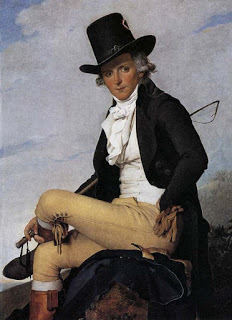 David, Pierre Sériziat, 1795
Loretta reports:
David, Pierre Sériziat, 1795
Loretta reports:Not very long ago, a reader who’d happened upon Susan’s post about 18th C men’s shirts , asked what an English gentleman’s stock was made of, saying, “In painting of the era it seems to be of a very light material as there are multiple folds.”
I brought the question to Mark Hutter , Master Taylor in Colonial Williamsburg’s Historic Trades Department.
The answer, as is the case so often with fashion, is, “It depends.” But he did clarify further, as well as guiding me toward several resources for my investigation. A gentleman’s choice of fabric to put around his neck would depend on the time period as well as the occasion, his bank account, and his personal taste. As Mark pointed out to a visitor, there’s no “typical.”
Because it’s a huge subject, I’m picking one era, place, and financial situation, the one in my stories: early 19th C British gentlemen of the upper classes.
According to Ian Kelley’s Beau Brummell , the dandy’s neckcloth was “a triangle of fine Irish muslin, cut diagonally from a square yard and plainly seamed.” From what I can ascertain, fine Irish muslin would have been quite expensive.
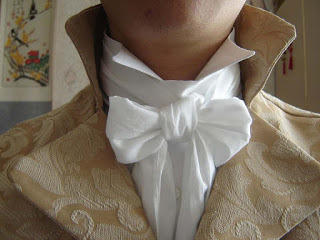 Regency style neckcloth
Regency style neckcloth
It gets tricky, distinguishing between cotton and linen fabrics. Undergarments like shirts, neckcloths, collars would be referred to as “linen,” though they might be made of other material. Good cotton, however, as far as I can discover, wasn’t cheap. The famous muslin dresses Regency ladies wore were made of fabric imported from India, and like their miles-long cashmere shawls, displayed their wealth.
Mark mentioned lawn and cambric, terms some of our readers might have come across in their reading. According to Harmuth’s Dictionary of Textiles, lawn is “a plain woven, very light, soft, smooth and sheer cotton or linen wash dress goods ... similar to cambric but lighter.” Irish lawn is “very fine, plain woven, bleached lawn, made of pure, hard-spun ply linen yarn.”
To answer the reader’s question, then, the neckcloths in the portraits were of quite fine material, most likely of linen or muslin. The white neckcloth* we see so often in Regency portraits would have been lightly starched to allow one to create the correct folds. Too much starch would make it too stiff. Usually. A few styles, it turns out, demanded stiffer fabric. But that’s another topic.
In the next post, we’ll take a look at the incredibly tricky business of tying these things.
*They came in other colors, as well as in silk, but we’ll deal with that later, too. Eventually.
Image: Jacques-Louis David, Portrait of Pierre Sériziat , 1795, Louvre Museum
English: A Regency style neckcloth tied in a bow on a starched Grafton collar . Attribution: CharlieHuang at English Wikipedia
Clicking on the image will enlarge it. Clicking on the caption will take you to the source, where you can learn more and enlarge images as needed.
Published on April 11, 2018 21:30
April 9, 2018
Wall Street & the Tontine Coffee House: New York City in 1797
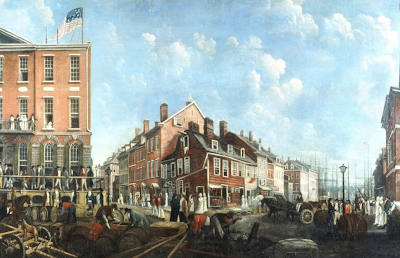 Susan reporting,
Susan reporting,While I'm not *quite* ready yet to reveal the title and subject of my next historical novel, the painting shown here will offer clues galore. This is a view of Wall Street in New York City around 1797, between the modern Water and Front Streets, in what is now the heart of the Financial District.
Writing novels set in the early years of America can offer many challenges, including the the small number of drawings, prints, and paintings (and of course no photographs) showing the cities and landscapes of the time. Set a story in 1790s London, and there are countless primary images for inspiration while creating a character's "world." Resources like those are much harder to find for the young United States. Professional artists were rare in 18thc America, and often the best surviving paintings and drawings of places are the work of visitors from abroad (like these panoramic watercolors, here and here , by Frenchman Pierre L'Enfant, or this view of the Hudson River by British Lieutenant Thomas Davies.)
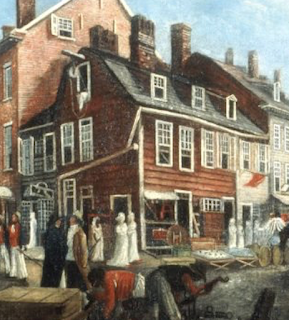
All of which makes this painting of the New York, (above, with details below; click to enlarge), that my characters would have known especially useful to me. This street corner would have been familiar to Eliza and Alexander Hamilton in I, Eliza Hamilton , and it's equally well-known to my new characters, too. The scale of 18thc New York may bear little resemblance to the towering skyscrapers of today, but the city's legendary intensity is already present. Every person (and even the dog in the lower left) seems filled with energy and purpose as the Stars and Stripes snaps and flutters in breeze.
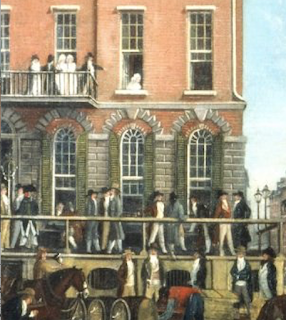
At this time, Wall Street led directly to the waterfront and the East River wharves, the source of much of the city's wealth and power. Those tall masts at the end of the street must have been a constant reminder that New York was a flourishing international port, sending ships not only to Europe, but to destinations in Africa, South America, and the faraway Pacific. The cargo in these ships included coffee, sugar, and tea, silk, cotton, and linen, fine furnishings and silver. It could also include enslaved men, women, and children, for slavery was still legal in New York, and many households and businesses, large and small, relied on enslaved workers.
Coffee houses played an important role in 18thc New York, and two of the most notable appear in this painting. The small clapboard building on the corner with the gambrel roof is the Merchants' Coffee House, one of the gathering-places for political discussions during the Revolution, and later, during the 1780s, the site of the creation and organization of the Bank of New York. Across the street and nearly out of the left side of the painting is the Tontine Coffee House. This was the first home of the New York Stock Exchange, and of merchant activity of every kind.
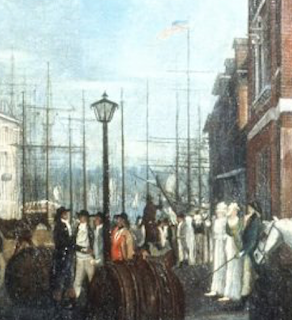
According to Travels through Lower Canada, & the United States of North America, in the Years 1806, etc. by John Lambert (published in 1810):
"The Tontine coffee-house was filled with underwriters, brokers, merchants, traders and politicians; selling, purchasing, trafficking, or insuring; some reading, others eagerly inquiring the news. The steps and balcony of the coffee-house were crowded with people bidding, or listening to several auctioneers....Every thing was in motion; all was life, bustle, and activity....Every thought, word, look, and action of the multitude seemed to be absorbed by commerce...and all were eager in the pursuit of its riches."
Above: Tontine Coffee House, New York City by Francis Guy, c1797, New-York Historical Society.
Published on April 09, 2018 21:00
Wall Street, New York City in 1797
 Susan reporting,
Susan reporting,While I'm not *quite* ready yet to reveal the title and subject of my next historical novel, the painting shown here will offer clues galore. This is a view of Wall Street in New York City around 1797, between the modern Water and Front Streets, in what is now the heart of the Financial District.
Writing novels set in the early years of America can offer many challenges, including the the small number of drawings, prints, and paintings (and of course no photographs) showing the cities and landscapes of the time. Set a story in 1790s London, and there are countless primary images for inspiration while creating a character's "world." Resources like those are much harder to find for the young United States. Professional artists were rare in 18thc America, and often the best surviving paintings and drawings of places are the work of visitors from abroad (like these panoramic watercolors, here and here , by Frenchman Pierre L'Enfant, or this view of the Hudson River by British Lieutenant Thomas Davies.)

All of which makes this painting of the New York, (above, with details below; click to enlarge), that my characters would have known especially useful to me. This street corner would have been familiar to Eliza and Alexander Hamilton in I, Eliza Hamilton , and it's equally well-known to my new characters, too. The scale of 18thc New York may bear little resemblance to the towering skyscrapers of today, but the city's legendary intensity is already present. Every person (and even the dog in the lower left) seems filled with energy and purpose as the Stars and Stripes snaps and flutters in breeze.

At this time, Wall Street led directly to the waterfront and the East River wharves, the source of much of the city's wealth and power. Those tall masts at the end of the street must have been a constant reminder that New York was a flourishing international port, sending ships not only to Europe, but to destinations in Africa, South America, and the faraway Pacific. The cargo in these ships included coffee, sugar, and tea, silk, cotton, and linen, fine furnishings and silver. It could also include enslaved men, women, and children, for slavery was still legal in New York, and many households and businesses, large and small, relied on enslaved workers.
Coffee houses played an important role in 18thc New York, and two of the most notable appear in this painting. The small clapboard building on the corner with the gambrel roof is the Merchants' Coffee House, one of the gathering-places for political discussions during the Revolution, and later, during the 1780s, the site of the creation and organization of the Bank of New York. Across the street and nearly out of the left side of the painting is the Tontine Coffee House. This was the first home of the New York Stock Exchange, and of merchant activity of every kind.

According to Travels through Lower Canada, & the United States of North America, in the Years 1806, etc. by John Lambert (published in 1810):
"The Tontine coffee-house was filled with underwriters, brokers, merchants, traders and politicians; selling, purchasing, trafficking, or insuring; some reading, others eagerly inquiring the news. The steps and balcony of the coffee-house were crowded with people bidding, or listening to several auctioneers....Every thing was in motion; all was life, bustle, and activity....Every thought, word, look, and action of the multitude seemed to be absorbed by commerce...and all were eager in the pursuit of its riches."
Which sounds much like New York today, doesn't it?
Above: Tontine Coffee House, New York City by Francis Guy, c1797, New-York Historical Society.
Published on April 09, 2018 21:00
April 8, 2018
Fashions for April 1833
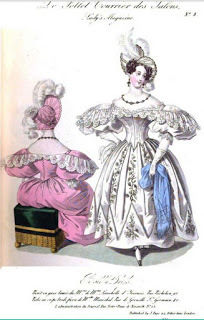 April 1833 Ball Dress
April 1833 Ball Dress
Loretta reports:
Since my new series, Difficult Dukes, is set in 1833, and we’re up to the 1830s in the monthly fashion prints, it made sense to offer sample fashions from that year. You’ve seen enough of the 1830s images by now to be familiar with the immense sleeves and lofty approach to hair styles and headwear. These plates, published in The Lady's Magazine and Museum (Improved series, Enlarged Vol. 2), uses the high quality French engravings, rather than some of the cheap copies we see elsewhere.
You will notice, in the ball dress description, that the corset-style top can be a different color from the dress. Indeed, any of these dresses might have been made in other colors and fabrics, with individual touches. Somewhere there may be a fashion plate with the dress in two colors, since the engravings were hand colored, and the publisher would have employed more than one artist.
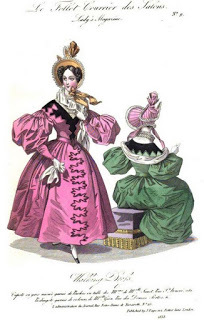 April 1833 Walking Dress
April 1833 Walking Dress
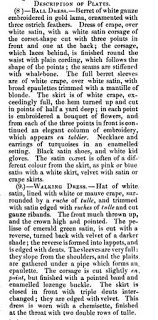 Dress description
Dress description
Clicking on the image will enlarge it. Clicking on the caption will take you to the source, where you can learn more and enlarge images as needed.
Published on April 08, 2018 21:30
March 25, 2018
Gone Fishin'—Spring Break
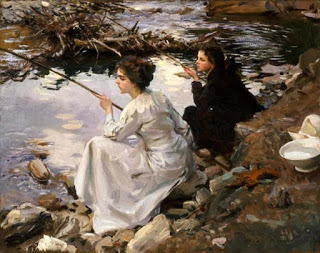 Susan and Loretta report:
Susan and Loretta report:Spring is officially here, although it doesn't feel much like it in some parts of the U.S.—and, from what we've seen—elsewhere in the world.
But it's spring break time for the Two Nerdy History Girls. We're going to take the week off from blogging, and look determinedly for signs of spring, in between working on our books. And maybe goofing off a little.
See you next week!
Image: John Singer Sargent, Two Girls Fishing , 1912, Cincinnati Art Museum, Eden Park, via Wikipedia.
Clicking on the image will enlarge it.
Published on March 25, 2018 21:30
March 24, 2018
Breakfast Links: Week of March 19, 2018
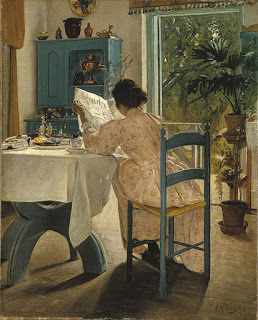 Breakfast Links are served - our weekly round-up of fav links to other web sites, articles, blogs, and images via Twitter.
Breakfast Links are served - our weekly round-up of fav links to other web sites, articles, blogs, and images via Twitter.• Secrets of a 19thc brothel privy .
• Preserving a remarkably original Regency townhouse .
• Image: A 19thc sack that held a dress, pecans, braid of hair, & "love always " from enslaved Rose to her nine-year-old daughter Ashley when she was sold away form her.
• This newly-restored Georgian water pump in London was partially paid for by the East India Company.
• Published and damned: the shocking life of Harriette Wilson .
• Poison and protest : Sarah Bassett and enslaved women poisoners in the early modern Caribbean.
• The Dark Man: an 1893 story of an Irish changeling .
• Image: 415-year-old corset (or "pair of straight bodies") from funeral effigy of Elizabeth I prepared for display at Westminster Abbey; follow thread for more photos.
• The world's oldest decorated eggs pre-date Christianity.
• A transcribed recipe for 17thc Apple Snow to try at home.
• The British Newspaper Archives have digitized several newspapers linked to women's suffrage movement to read online.
• Videos, broadsides, letters, & artifacts: highlights of The Irish Atlantic exhibition from the Massachusetts Historical Society to view online.
• Image: In 1951, a columnist complained that Marilyn Monroe was "cheap & vulgar" and would have looked more decent in a potato sack; Marilyn's response was these photos .
• Bobbi Gibb , the woman who crashed the Boston Marathon in 1966.
• A walk through time, Spitalfields Market, London.
• Catharine Macaulay, the 18thc author of The History of England.
• A 1790s French neoclassical woman's slipper , resplendent with sequins.
• Image: Pre-modern artists imagined female superheroes in functional armor: Penthesilea , a brave woman, detail of medieval tapestry in the Angers Castle.
Hungry for more? Follow us on Twitter @2nerdyhistgirls for fresh updates daily.
Above: At Breakfast by Laurits Andersen Ring. Private collection.
Published on March 24, 2018 14:00
March 22, 2018
Friday Video: A Moving Panorama of the Mississippi Valley
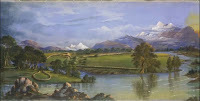 Loretta reports:
Loretta reports: Many of the 1830s magazines I peruse include reviews of recently installed panoramas (please scroll down for the review about Niagara Falls). The moving panorama is also a large painting, but where the panorama requires the viewer to move around a room, the moving panorama is an early "moving picture." Using spools, it scrolls across a stage, creating the illusion of traveling along a scenic route.
Before photography and movies, both the still and the moving paintings offered Londoners as well as Americans views of distant locales. Since the Londoners seem to have been especially curious about the U.S. and its wildernesses, I’m sure they would have enjoyed John J. Egan’s “Panorama of the Monumental Grandeur of the Mississippi Valley”—all 348 feet of it, and a very rare survivor.
Video: John J. Egan's " Panorama of the Monumental Grandeur of the Mississippi Valley "
Credits Animation: Paul Caro Photography: Saint Louis Art Museum © 2015 The Metropolitan Museum of Art. Image is a still from the video.
Readers who receive our blog via email might see a rectangle, square, or nothing where the video ought to be. To watch the video, please click on the title to this post or the title of the video.
Published on March 22, 2018 21:30
March 21, 2018
Lustrous Luxury: Eighteenth-Century Coque de Perle Earrings
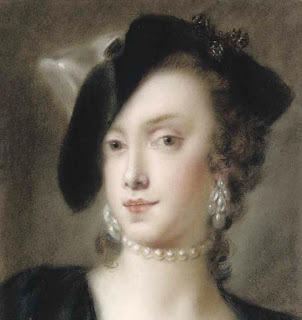 Susan reporting,
Susan reporting,One of the very best parts of blogging and social media in general is the opportunity to share images and inspiration with other like-minded folk. Last week, I saw the earrings upper right with a short explanation on the Instagram page of Taylor Autumn Shelby, a friend of this blog as well as the creator of replicas of historic jewelry.
I had never heard of 18thc coque de perle earrings before, but I realized I'd seen them in portraits like the one upper left: earrings with oval-shaped pearls that were far too large to be real, but were clearly prized enough to be featured in portraits. Pearls have been in fashion since ancient times, but before the invention of cultured pearls in the early 20thc, true pearls were rare and prohibitively expensive except for the very rich or very royal. I knew about Roman pearls, another kind of 18thc faux pearl that were glass beads lined with a pearly coating (see my earlier posts here and here ), but coques de perle was new to me, and off I went to hunt for more information.
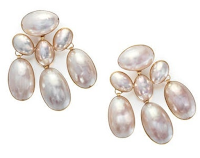
According to the Museum of Fine Arts in Boston, who owns the earrings lower right, each coque de perle (literally "pearl shell") is cut from the East Indian nautilus shell; the result is similar to a blister or mabe pearl. They are not rounded, but flat or hollowed on one side, and can be made quite large in size. The shape is usually oval (often described as olive) to follow the natural curve of the shell. The hollowed curve could be filled with wax or resin to give the finished coque de perle more of the weight of a true pearl, or left hollow to keep it light; I'm guessing that is the case of the pearl swinging from the large hoop earring in the Vigée Le Brun portrait, lower left. Some coques de perle were set in gold or silver like true pearls, while others were set in a base metal to make them more affordable.
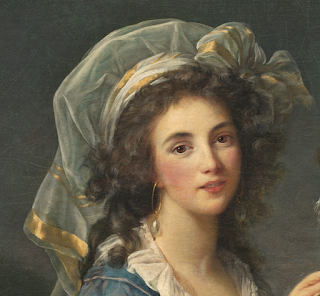
I also found this description of coques de perle in the 1814 edition of A History of Inventions and Discoveries by Johann Beckmann, who in turn quotes 1762 French expert Jean Henri Prosper Pouget:
"Coque de perles are flat on one side, and are used for ornaments, one side of which only is seen. By Pliny they are called physemata. Artificial pearls of this kind have, for some time past, been employed in making ear-rings. Our toymen [jewelers], after the French, give these pearls the name perles coques; but the following account of Pouget in Traité des pierres precieuses et de la manière de les employer en parure [A Treatis on precious stones and how to use them for adornment] makes me dubious respecting them. 'La coque de perle,' says he, "is not formed in a pearl-shell like the pearl; it is procured from a kind of snail found only in the East-Indies. There are several species of them. The shell of this animal is sawn in two, and one coque only can be obtained from each. The coques are very small, and one is obliged to fill them with tears of mastic to give them a body, before they can be employed. This beautiful snail is found generally in the sea, and sometimes on the shore.'"
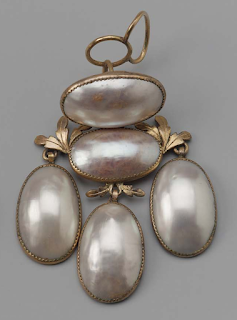
A beautiful snail, and beautiful earrings as well.
Upper left: Ritratto de Caterina Sagredo Barbarigo by Rosalba Carriera, 1741, private collection.
Upper right: Coque de Perle Girandole Earrings, 18thc, image via Bonhams Auctioneers.
Lower left, Detail, The Marquise de Pezay, and the Marquise de Rougé with Her Sons Alexis and Adrien by Élisabeth-Louise Vigée Le Brun, 1797, National Gallery of Art, Washington, DC.
Lower right: Girandole Style Earring (one of a pair; gold metal and coque de perle) English, about 1780, Museum of Fine Arts, Boston.
Published on March 21, 2018 17:41
March 19, 2018
Lord Rivers Drowns in the Serpentine—Was It an Accident?
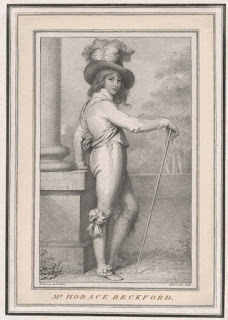 Lord Rivers as a boy
Loretta reports:
Lord Rivers as a boy
Loretta reports:Georgiana, Duchess of Devonshire, was addicted to gambling. The first Lord Holland’s sons ran up enormous gambling debts. Beau Brummell fled England to escape his. A lot of that going around.
The third Baron Rivers is another example I happened on. The trail started with the following in La Belle Assemblée for March 1831:
“The first act of the Duke of Sussex, on being appointed to the Rangership of Hyde-park, has been to give directions for the placing an adequate protection against the spot where the late Lord Rivers lost his life."This was intriguing. Who was Lord Rivers and how did he die?
Wikipedia’s short entry only tantalized, sending me to the 1 April 1831 Gentleman’s Magazine obituary .
LORD RIVERS.
Jan. 23 Drowned in the Serpentine river, aged 53, the Right Hon. Horace William Pitt, third Baron Rivers, of Sudeley Castle in Gloucestershire (1802).
... As Mr. Horace Beckford he was for many years a distinguished member of the haut ton; and it was only after his succeeding to the title on the death of his maternal uncle, July 20, 1828, that he took the name of Pitt ... .
“Lord Rivers was first missed on the evening of Sunday Jan. 23 ... On Tuesday the Serpentine river was dragged, and in the afternoon his Lordship's body was found at the east end, near the waterfall.”At the inquest, his steward and a footman insisted he’d been in good spirits: He was nearsighted and must have fallen into the river by accident. The superintendent of the Humane Society's Receiving House said the footpath there was so dangerous that ten people fell into the river on a recent foggy night.
“The Jury returned this verdict: ‘Found drowned near the public path at the head of the Serpentine River, considered very dangerous for want of a rail or fence, where many persons have lately fallen in.’—The rail has been since erected by direction of the Duke of Sussex, the new Ranger of Hyde Park.
Subsequently to the inquest ..., there has been considerable discussion in the newspapers regarding the cause of the occurrence; and it has been stated, with what truth we cannot say, that when the body was taken out of the water, his Lordship's hat was secured with a handkerchief under his chin, and that his umbrella was found on the bank, both which circumstances are considered indicative that his immersion was intentional; and it is added that on the Saturday night he had lost considerable sums at a gaming-house; and that this passion for play had for some years so far possessed him, that his uncle bequeathed to him only 4000l. a year, leaving the bulk of his property, amounting to 40,000l a year, to trustees for the benefit of his son, the present Peer.”
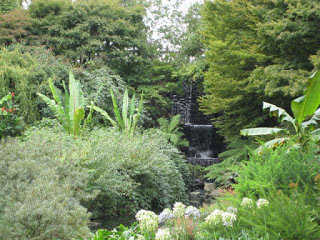 Nigel Cox, Serpentine Waterfall
It’s important to remember that suicide, being self-murder, was a capital offense. One could be tried and hanged for the attempt, and a suicide’s property was forfeit to the Crown. Up to a certain point in the early 19th C, those who’d committed suicide were buried at midnight at a crossroads without the offices of clergy. This is why coroner’s juries tended to find the deaths accidental or, when this was impossible, the victim of unsound mind.
Nigel Cox, Serpentine Waterfall
It’s important to remember that suicide, being self-murder, was a capital offense. One could be tried and hanged for the attempt, and a suicide’s property was forfeit to the Crown. Up to a certain point in the early 19th C, those who’d committed suicide were buried at midnight at a crossroads without the offices of clergy. This is why coroner’s juries tended to find the deaths accidental or, when this was impossible, the victim of unsound mind.Image: A print of the “ youthful portrait of Mr. Horace Beckford , at full length in a Vandyke costume, painted by R. Cosway, R.A. and engraved in stipple by John Conde, 1792", courtesy the Metropolitan Museum of Art
Photo of Serpentine Waterfall by Nigel Cox. Another image here .
Clicking on the image will enlarge it. Clicking on the caption will take you to the source, where you can learn more and enlarge images as needed.
Published on March 19, 2018 21:30



